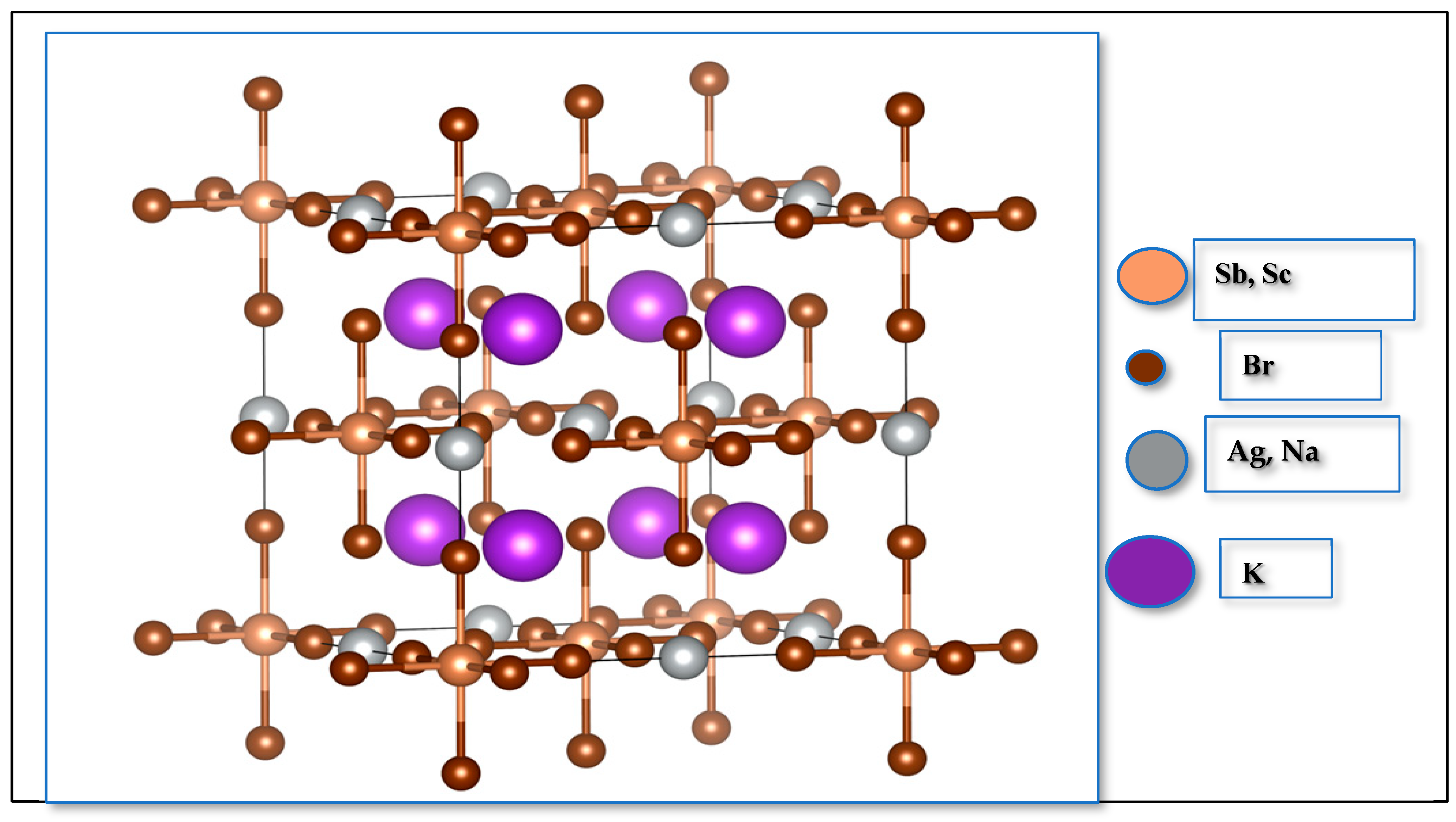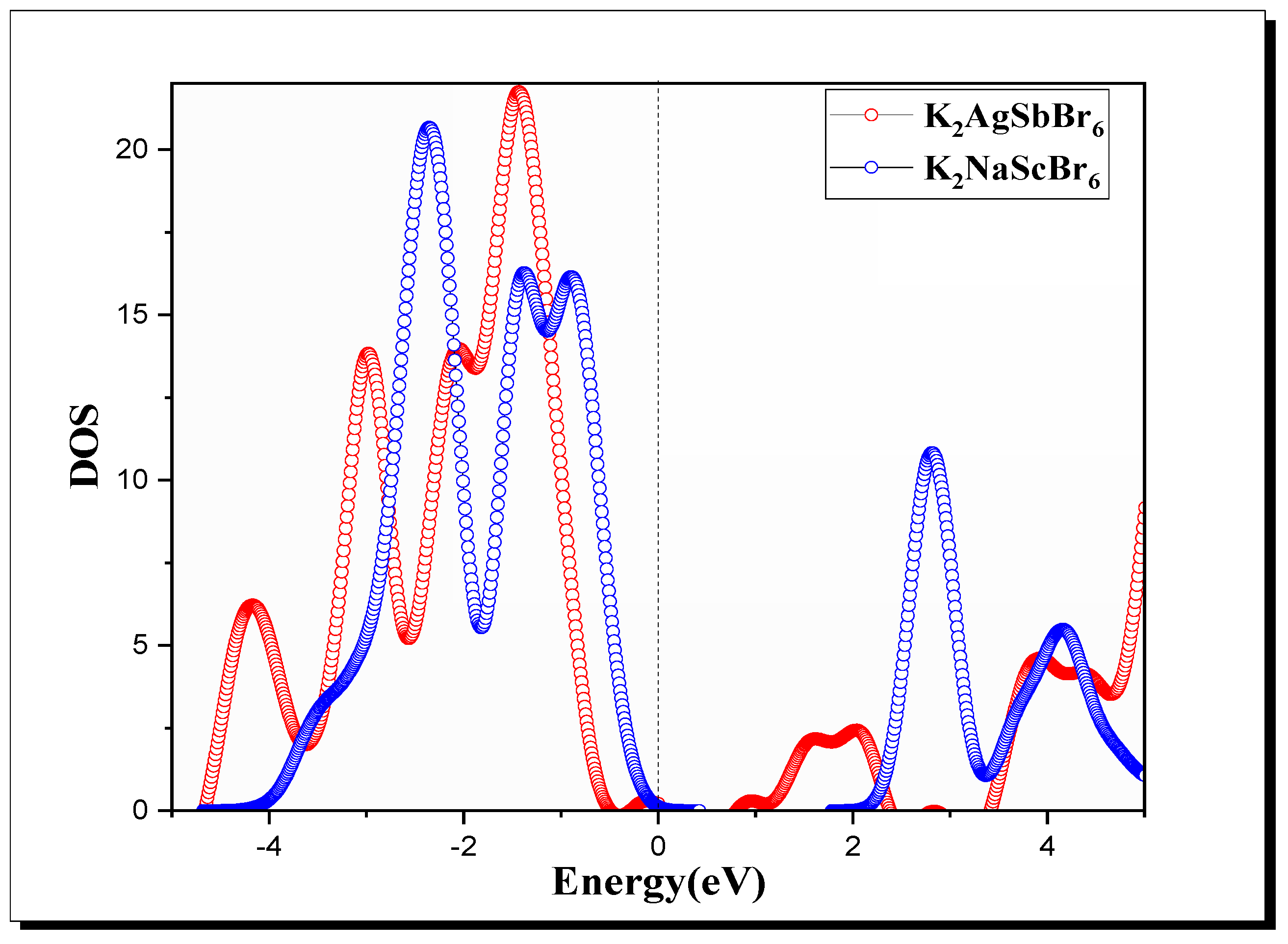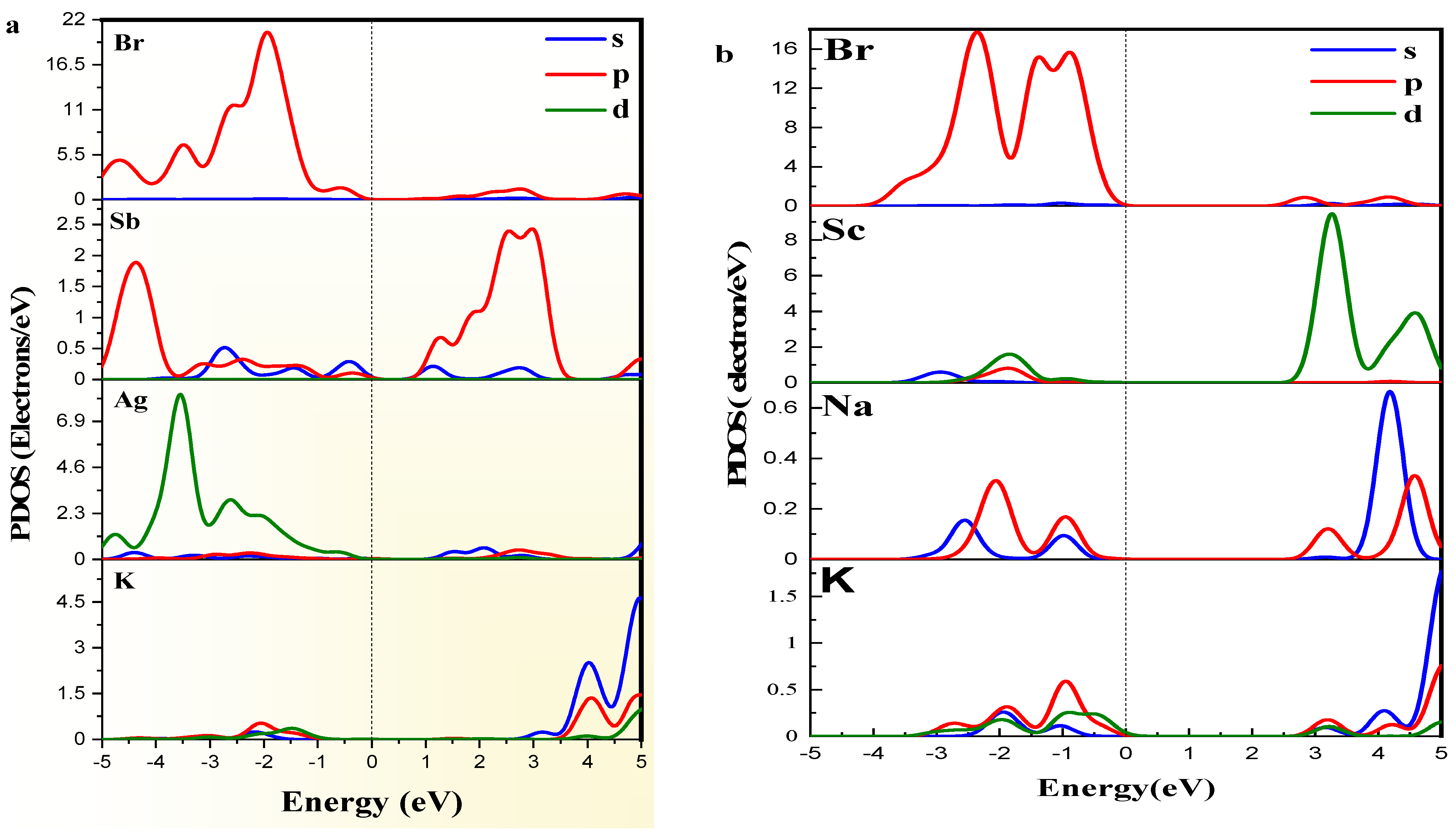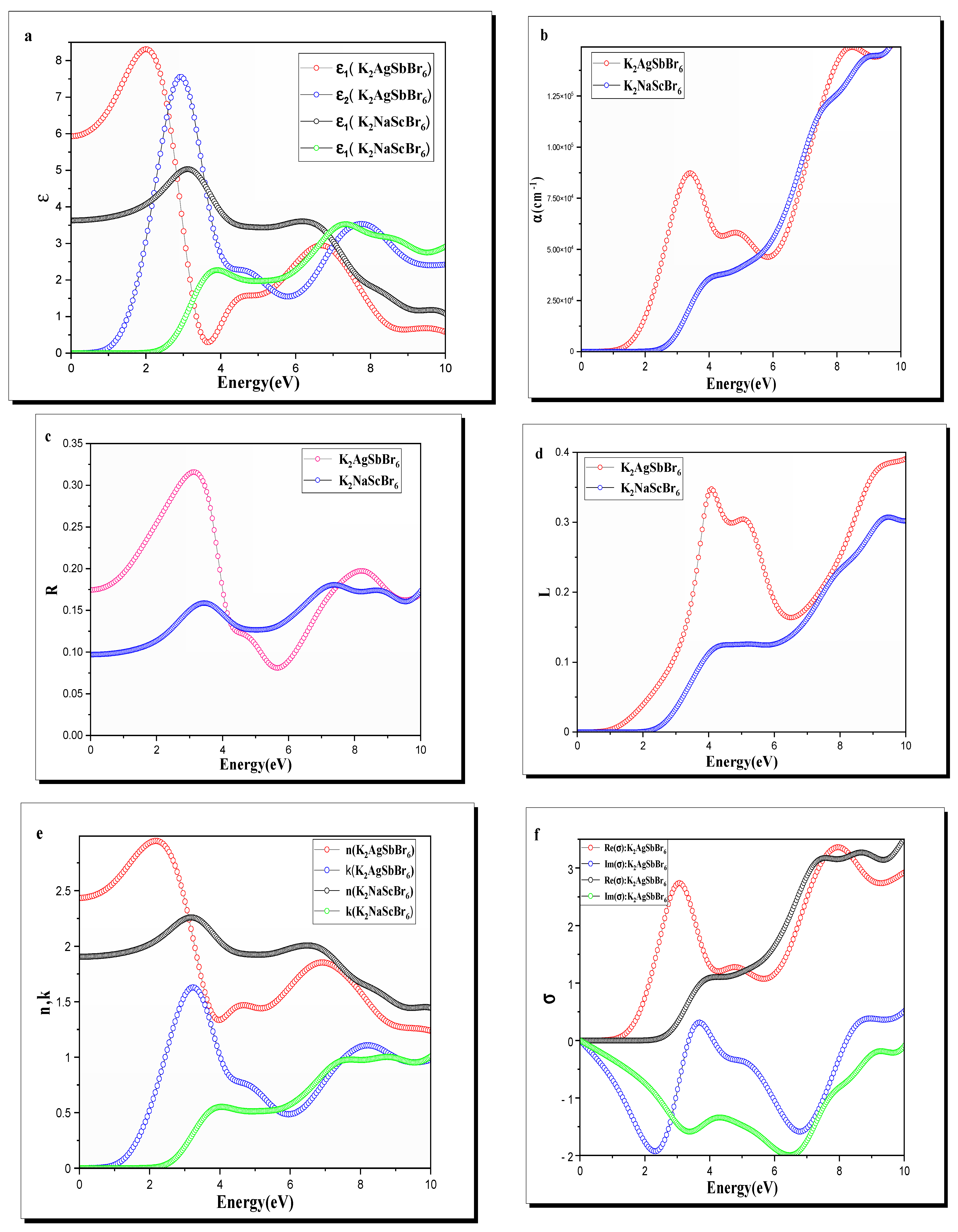Comparative DFT Study of K2AgSbBr6 and K2NaScBr6: Exploring the Role of B′B″ Cation Substitution on Material Properties
Abstract
1. Introduction
2. Results and Discussions
2.1. Structural Properties and Stability
2.2. Mechanical Properties
2.3. Electronic Properties
2.4. Optical Properties
3. Materials and Methods
4. Conclusions
Author Contributions
Funding
Data Availability Statement
Conflicts of Interest
References
- Chen, S.; Yin, H.; Liu, P.; Wang, Y.; Zhao, H. Stabilization and Performance Enhancement Strategies for Halide Perovskite Photocatalysts. Adv. Mater. 2023, 35, 2203836. [Google Scholar] [CrossRef] [PubMed]
- Li, J.; Duan, J.; Yang, X.; Duan, Y.; Yang, P.; Tang, Q. Review on Recent Progress of Lead-Free Halide Perovskites in Optoelectronic Applications. Nano Energy 2021, 80, 105526. [Google Scholar] [CrossRef]
- Zhang, K.; Zhang, L.; Saravana Karthikeyan, S.K.S.; Kong, C.Y.; Zhang, F.; Guo, X.; Dang, N.N.; Ramaraj, S.G.; Liu, X. Structural, Electronic, Optical, Elastic, Thermodynamic and Thermal Transport Propertie of Cs2AgInCl6 and Cs2AgSbCl6 Double Perovskite Semiconductors Using a First-Principles Study. Phys. Chem. Chem. Phys. 2023, 25, 31848–31868. [Google Scholar] [CrossRef]
- Baikie, T.; Fang, Y.; Kadro, J.M.; Schreyer, M.; Wei, F.; Mhaisalkar, S.G.; Graetzel, M.; White, T.J. Synthesis and Crystal Chemistry of the Hybrid Perovskite (CH3NH3)PbI3 for Solid-State Sensitised Solar Cell Applications. J. Mater. Chem. A Mater. 2013, 1, 5628. [Google Scholar] [CrossRef]
- Bakulin, A.A.; Selig, O.; Bakker, H.J.; Rezus, Y.L.A.; Müller, C.; Glaser, T.; Lovrincic, R.; Sun, Z.; Chen, Z.; Walsh, A.; et al. Real-Time Observation of Organic Cation Reorientation in Methylammonium Lead Iodide Perovskites. J. Phys. Chem. Lett. 2015, 6, 3663–3669. [Google Scholar] [CrossRef]
- deQuilettes, D.W.; Zhang, W.; Burlakov, V.M.; Graham, D.J.; Leijtens, T.; Osherov, A.; Bulović, V.; Snaith, H.J.; Ginger, D.S.; Stranks, S.D. Photo-Induced Halide Redistribution in Organic–Inorganic Perovskite Films. Nat. Commun. 2016, 7, 11683. [Google Scholar] [CrossRef]
- Zhao, Y.-C.; Zhou, W.-K.; Zhou, X.; Liu, K.-H.; Yu, D.-P.; Zhao, Q. Quantification of Light-Enhanced Ionic Transport in Lead Iodide Perovskite Thin Films and Its Solar Cell Applications. Light Sci. Appl. 2016, 6, e16243. [Google Scholar] [CrossRef]
- Igbari, F.; Xu, F.-F.; Shao, J.-Y.; Ud-Din, F.; Siffalovic, P.; Zhong, Y.-W. Stacking Interactions and Photovoltaic Performance of Cs2AgBiBr6 Perovskite. Sol. RRL 2023, 7, 2200932. [Google Scholar] [CrossRef]
- Mathew, N.P.; Rajeev Kumar, N.; Radhakrishnan, R. First Principle Study of the Structural and Optoelectronic Properties of Direct Bandgap Double Perovskite Cs2AgInCl6. Mater. Today Proc. 2020, 33, 1252–1256. [Google Scholar] [CrossRef]
- Yuan, Y.; Wang, Q.; Shao, Y.; Lu, H.; Li, T.; Gruverman, A.; Huang, J. Electric-Field-Driven Reversible Conversion Between Methylammonium Lead Triiodide Perovskites and Lead Iodide at Elevated Temperatures. Adv. Energy Mater. 2016, 6, 4122–4128. [Google Scholar] [CrossRef]
- Wu, Y.; Li, X.; Zeng, H. Lead-Free Halide Double Perovskites: Structure, Luminescence, and Applications. Small Struct. 2021, 2, 2000071. [Google Scholar] [CrossRef]
- Ji, F.; Boschloo, G.; Wang, F.; Gao, F. Challenges and Progress in Lead-Free Halide Double Perovskite Solar Cells. Sol. RRL 2023, 7, 2201112. [Google Scholar] [CrossRef]
- Sakhatskyi, K.; Turedi, B.; Matt, G.J.; Wu, E.; Sakhatska, A.; Bartosh, V.; Lintangpradipto, M.N.; Naphade, R.; Shorubalko, I.; Mohammed, O.F.; et al. Stable Perovskite Single-Crystal X-Ray Imaging Detectors with Single-Photon Sensitivity. Nat. Photonics 2023, 17, 510–517. [Google Scholar] [CrossRef]
- Bai, Y.; Hao, M.; Ding, S.; Chen, P.; Wang, L. Surface Chemistry Engineering of Perovskite Quantum Dots: Strategies, Applications, and Perspectives. Adv. Mater. 2022, 34, 2105958. [Google Scholar] [CrossRef]
- Liu, Y.; Jing, Y.; Zhao, J.; Liu, Q.; Xia, Z. Design Optimization of Lead-Free Perovskite Cs 2 AgInCl6:Bi Nanocrystals with 11.4% Photoluminescence Quantum Yield. Chem. Mater. 2019, 31, 3333–3339. [Google Scholar] [CrossRef]
- Zhang, L.; Fang, Y.; Sui, L.; Yan, J.; Wang, K.; Yuan, K.; Mao, W.L.; Zou, B. Tuning Emission and ElectronPhonon Coupling in Lead-Free Halide Double Perovskite Cs2AgBiCl6 under Pressure. ACS Energy Lett. 2019, 4, 2975–2982. [Google Scholar] [CrossRef]
- Dong, C.; Guan, X.; Wang, Z.; Zhao, H.; Kuai, Y.; Gao, S.; Chen, C.; Zou, W.; Lu, P. The Effects of Cation and Halide Anion on the Stability, Electronic and Optical Properties of Double Perovskite Cs2NaMX6 (M = In, Tl, Sb, Bi; X = Cl, Br, I). Comput. Mater. Sci. 2023, 220, 112058. [Google Scholar] [CrossRef]
- Shadabroo, M.S.; Abdizadeh, H.; Golobostanfard, M.R. Elpasolite Structures Based on A2AgBiX6 (A: MA, Cs, X: I, Br): Application in Double Perovskite Solar Cells. Mater. Sci. Semicond. Process. 2021, 125, 105639. [Google Scholar] [CrossRef]
- Tran, T.T.; Panella, J.R.; Chamorro, J.R.; Morey, J.R.; McQueen, T.M. Designing Indirect–Direct Bandgap Transitions in Double Perovskites. Mater. Horiz. 2017, 4, 688–693. [Google Scholar] [CrossRef]
- Munio, A.A.Z.; Liboon, A.Q., Jr.; Lagud, Y.J.; Patayon, U.B.; Pido, A.A.G.; Karouchi, M.; Ambolode II, L.C.C. A Density Functional Theory Study on the Interaction of Cellulose Biopolymer and Atomic Arsenic. Solid State Phenom. 2023, 352, 39–46. [Google Scholar] [CrossRef]
- Iqbal, J.; Ullah, H.; Archi, M.; Ullah, N.; Ullah, S.; Ullah, R.; Iqbal, Z. Enchanting Optical, Electronic, and Mechanical Properties of the Sodium Based Na2MgSiZ6 (Z = I, Br, Cl) Halides Have Been Explored through DFT. Phys. Scr. 2024, 99, 115949. [Google Scholar] [CrossRef]
- Ejjabli, A.; Karouchi, M.; Al-Hattab, M.; Bajjou, O.; Rahmani, K.; Lachtioui, Y. Investigation of Lead-Free Halide K2AgSbBr6 Double Perovskite’s Structural, Electronic, and Optical Properties Using DFT Functionals. Chem. Phys. Impact 2024, 9, 100656. [Google Scholar] [CrossRef]
- Jamshaid, S.; Nasarullah; Aldaghfag, S.A.; K Butt, M.; Yaseen, M.; Murtaza, A.; Ishfaq, M.; Hegazy, H.H. Investigation of Cubic K2NaXBr6(X=Sc, Y) Double Perovskites for Optical and Thermoelectric Devices. J. Phys. Chem. Solids 2023, 178, 111341. [Google Scholar] [CrossRef]
- Wallace, D.C.; Patrick, J.L. Stability of Crystal Lattices. Phys. Rev. 1965, 137, A152–A160. [Google Scholar] [CrossRef]
- Feng, L.M.; Jiang, L.Q.; Zhu, M.; Liu, H.B.; Zhou, X.; Li, C.H. Formability of ABO3 Cubic Perovskites. J. Phys. Chem. Solids 2008, 69, 967–974. [Google Scholar] [CrossRef]
- Bartel, C.J.; Sutton, C.; Goldsmith, B.R.; Ouyang, R.; Musgrave, C.B.; Ghiringhelli, L.M.; Scheffler, M. New Tolerance Factor to Predict the Stability of Perovskite Oxides and Halides. Sci. Adv. 2019, 5, eaav0693. [Google Scholar] [CrossRef]
- Emery, A.A.; Wolverton, C. High-Throughput DFT Calculations of Formation Energy, Stability and Oxygen Vacancy Formation Energy of ABO3 Perovskites. Sci. Data 2017, 4, 170153. [Google Scholar] [CrossRef] [PubMed]
- Laassouli, A.; Karouchi, M.; Ejjabli, A.; Lachtioui, Y.; Bajjou, O. DFT Study on K2AgSbI6: Exploring the Electronic, Optical, and Elastic Properties of a Double Perovskite. Solid State Commun. 2025, 402, 115947. [Google Scholar] [CrossRef]
- Arikan, N.; DikiCi Yildiz, G.; Yildiz, Y.G.; İyigör, A. Electronic, Elastic, Vibrational and Thermodynamic Properties of HfIrX (X = As, Sb and Bi) Compounds: Insights from DFT-Based Computer Simulation. J. Electron. Mater. 2020, 49, 3052–3062. [Google Scholar] [CrossRef]
- Laassouli, A.; Moulaoui, L.; Najim, A.; Archi, M.; Karouchi, M.; Rahmani, K.; Lachtioui, Y.; Bajjou, O. Electronic and Optical Properties of Cl-Doped CH3NH3SnI3 Perovskite: A DFT Study. E3S Web Conf. 2025, 601, 00013. [Google Scholar] [CrossRef]
- Mouhat, F.; Coudert, F.-X. Necessary and Sufficient Elastic Stability Conditions in Various Crystal Systems. Phys. Rev. B 2014, 90, 224104. [Google Scholar] [CrossRef]
- Archi, M.; Moulaoui, L.; Karouchi, M.; Darkaoui, E.; Laassouli, A.; Bajjou, O.; Rahmani, K.; Manaut, B.; Elhadadi, B. First-Principles Study of Co-Doped Wurtzite ZnO: Insights into Carrier Dynamics, Visible Light Absorption, and Structural Properties for Solar Cell Applications. Opt. Quantum Electron. 2025, 57, 269. [Google Scholar] [CrossRef]
- Archi, M.; Bajjou, O.; Rahmani, K.; Elhadadi, B. Investigation of Structural, Phonon, Thermodynamic, Electronic, and Mechanical Properties of Non-Toxic XZnH3 (X = Li, Na, K) Perovskites for Solid-State Hydrogen Storage: A DFT and AIMD Approach. J. Energy Storage 2025, 112, 115492. [Google Scholar] [CrossRef]
- Archi, M.; Bajjou, O.; Rahmani, k.; Elhadadi, B. A Comparative Ab Initio Analysis of the Stability, Electronic, Thermodynamic, Mechanical, and Hydrogen Storage Properties of SrZnH3 and SrLiH3 Perovskite Hydrides through DFT and AIMD Approaches. Int. J. Hydrogen Energy 2025, 105, 759–770. [Google Scholar] [CrossRef]
- Razzaq, M.A. Mechanical, Electronic, Optical, and Thermoelectric Properties of Rb 2 TlGaX 6 (X = F, I) Lead-Free Double Perovskites: A First-Principles Study. Phys. Scr. 2025, 100, 015906. [Google Scholar] [CrossRef]
- Sajid, L.; Saeed, M.U.; Mashadi, S.H.; Abid, S.S.; Pervaiz, S.; Ali, Z.; Alanazi, Y.M.; Bacha, A.U.R.; Saeed, Y. Ab Initio Study of Electronic, Elastic, Thermodynamic, Photocatalytic Properties of Double Antiperovskite, Cs6AgBiX2 (X = Cl, Br, I). RSC Adv. 2024, 14, 35348–35359. [Google Scholar] [CrossRef]
- Ullah, H.M.N.; Rizwan, M.; Ali, S.S.; Usman, Z.; Cao, C. A DFT Study of Optical, Elastic, Mechanical, and Overall Water-Splitting Photocatalytic Properties of Pristine and Cd Substituted BaZrO3: A Lead Free Environment Friendly Material. Mater. Sci. Eng. B 2022, 286, 116041. [Google Scholar] [CrossRef]
- Karwasara, H.; Bhamu, K.C.; Kang, S.G.; Kushwaha, A.K.; Rai, D.P.; Sappati, S.; Sahariya, J.; Soni, A. Ab-Initio Investigations for Structural, Mechanical, Optoelectronic, and Thermoelectric Properties of Ba2SbXO6 (X[Dbnd]Nb, Ta) Compounds. J. Alloys Compd. 2022, 893, 162332. [Google Scholar] [CrossRef]
- Uddin, S.; Das, A.; Rayhan, M.A.; Ahmad, S.; Khokan, R.M.; Rasheduzzaman, M.; Das, R.; Ullah, A.; Arafat, Y.; Hasan, M.Z. Theoretical Prediction of the Mechanical, Electronic, Optical and Thermodynamic Properties of Antiperovskites A3BO (A = K, Rb and B = Au, Br) Using DFT Scheme: New Candidate for Optoelectronic Devices Application. J. Comput. Electron. 2024, 23, 1217–1237. [Google Scholar] [CrossRef]
- Alotaibi, N.H. Frist Principle Study of Double Perovskites Cs2AgSbX6 (X = Cl, Br, I) for Solar Cell and Renewable Energy Applications. J. Phys. Chem. Solids 2022, 171, 110984. [Google Scholar] [CrossRef]
- Saeed, M.; Haq, I.U.; Saleemi, A.S.; Rehman, S.U.; Haq, B.U.; Chaudhry, A.R.; Khan, I. First-Principles Prediction of the Ground-State Crystal Structure of Double-Perovskite Halides Cs2AgCrX6 (X = Cl, Br, and I). J. Phys. Chem. Solids 2022, 160, 110302. [Google Scholar] [CrossRef]
- Alotaibi, N.H.; Mustafa, G.M.; Kattan, N.A.; Mahmood, Q.; Albalawi, H.; Morsi, M.; Somaily, H.H.; Hafez, M.A.; Mahmoud, H.I.; Amin, M.A. DFT Study of Double Perovskites Cs2AgBiX6 (X = Cl, Br): An Alternative of Hybrid Perovskites. J. Solid State Chem. 2022, 313, 123353. [Google Scholar] [CrossRef]
- Karouchi, M.; Bajjou, O.; Jabraoui, H.; Ejjabli, A.; Archi, M.; Moulaoui, L.; Rahmani, K.; Lachtioui, Y. Increasing Electro-Optical Properties of Perovskite FAPbI3 Under the Effect of Doping by Sn. In Proceedings of the 2023 3rd International Conference on Innovative Research in Applied Science, Engineering and Technology (IRASET), Mohammedia, Morocco, 18–19 May 2023; pp. 1–7. [Google Scholar]
- Archi, M.; Bajjou, O.; Moulaoui, L.; Najim, A.; Karouchi, M.; Rahmani, K.; El haddadi, B. Electronic and Optical Properties of Different Concentrations of Ga Doped ZnO: CASTEP Study. In Proceedings of the 2023 3rd International Conference on Innovative Research in Applied Science, Engineering and Technology (IRASET), Mohammedia, Morocco, 18–19 May 2023; pp. 1–7. [Google Scholar]
- Ejjabli, A.; Karouchi, M.; Errahoui, H.; Bajjou, O.; Guerroum, J.; Elhajji, A.; Rahmani, K.; Lachtioui, Y. Electronic and Optical Properties of Double Perovskite Oxide LaFeWO6: A Theoretical Understanding from DFT Calculations. E3S Web Conf. 2024, 582, 02001. [Google Scholar] [CrossRef]
- Laassouli, A.; Moulaoui, L.; Najim, A.; Errahoui, H.; Rahmani, K.; Lachtioui, Y.; Omar Bajjou, O.B. Phosphorus Doping Effects on the Optoelectronic Properties of K2AgAsBr6 Double Perovskites for Photovoltaic Applications. Sol. Energy Sustain. Dev. J. 2024, 14, 1–11. [Google Scholar] [CrossRef]
- Errahoui, H.; Karouchi, M.; Ejjabli, A.; El haji, A.; Laassouli, A.; Ait El Alia, O.; Chaji, S.; Lachtioui, Y.; Bajjou, O. Impact of Calcium Doping on the Electronic and Optical Characteristics of Strontium Hydride (SrH2): A DFT Study. Atoms 2024, 12, 55. [Google Scholar] [CrossRef]
- Karouchi, M.; Ejjabli, A.; Bajjou, O.; Guerroum, J.; Al-Hattab, M.; Basyooni-M. Kabatas, M.A.; Rahmani, K.; Lachtioui, Y. Investigating the Structural, Electronic, and Optical Properties of the Novel Double Perovskite K2AgBiI6 Using DFT. Front. Mater. 2024, 11, 1448400. [Google Scholar] [CrossRef]
- Varadwaj, P.R.; Marques, H.M. The Cs2AgRhCl6 Halide Double Perovskite: A Dynamically Stable Lead-Free Transition-Metal Driven Semiconducting Material for Optoelectronics. Front. Chem. 2020, 8, 796. [Google Scholar] [CrossRef]
- Green, M.A.; Jiang, Y.; Soufiani, A.M.; Ho-Baillie, A. Optical Properties of Photovoltaic Organic–Inorganic Lead Halide Perovskites. J. Phys. Chem. Lett. 2015, 6, 4774–4785. [Google Scholar] [CrossRef]
- Karouchi, M.; Ejjabli, A.; Samine, S.; Bajjou, O.; Lachtioui, Y. Enhancing the Optoelectronic Properties of TiPbO3 Perovskite through Lanthanum Doping. Sol. Energy Sustain. Dev. J. 2024, 14, 142–155. [Google Scholar] [CrossRef]
- Ambrosch-Draxl, C.; Sofo, J.O. Linear Optical Properties of Solids within the Full-Potential Linearized Augmented Planewave Method. Comput. Phys. Commun. 2006, 175, 1–14. [Google Scholar] [CrossRef]
- Pingak, R.K.; Harbi, A.; Bouhmaidi, S.; Johannes, A.Z.; Hauwali, N.U.J.; Khan, W.; Nitti, F.; Tambaru, D.; Moutaabbid, M.; Setti, L. Novel Tl2GeX6 (X = Cl,Br) Double Perovskites for Solar Cell, Optoelectronic, and Thermoelectric Applications: A DFT Investigation. Chem. Phys. Impact 2024, 9, 100749. [Google Scholar] [CrossRef]
- Ayyaz, A.; Murtaza, G.; Umer, M.; Usman, A.; Raza, H.H. Structural, Elastic, Optoelectronic, and Transport Properties of Na-Based Halide Double Perovskites Na2CuMX6 (M = Sb, Bi, and X = Cl, Br) as Renewable Energy Materials: A DFT Insight. J. Mater. Res. 2023, 38, 4609–4624. [Google Scholar] [CrossRef]
- Al-Daraghmeh, T.M.; Nazir, G.; Zayed, O.; Kattan, N.A.; Rouf, S.A.; Albalawi, H.; Aljameel, A.I.; Boukhris, I. Tuning of Optical, Thermodynamic, and Thermoelectric Properties of Cs2CuBiX6 (X = Cl, Br, I) Halide Perovskites for Solar Cells and Energy Harvesting Applications. Phys. Scr. 2024, 99, 105969. [Google Scholar] [CrossRef]
- Hedhili, F.; Khan, H.; Sohail, M.; Rahman, N.; Khan, R.; Alahmad, W.; Albaqawi, H.S.; Al-Shomar, S.M.; Alsalmi, O. Structural, Electronic, Elastic, and Optical Characteristics of AgZF3 (Z = Sb and Bi) Fluoro-Perovskites: Using a Computational Approach for Energy Generation. Molecules 2023, 28, 4418. [Google Scholar] [CrossRef] [PubMed]
- Hasnip, P.J.; Refson, K.; Probert, M.I.J.; Yates, J.R.; Clark, S.J.; Pickard, C.J. Density Functional Theory in the Solid State. Philos. Trans. R. Soc. A Math. Phys. Eng. Sci. 2014, 372, 20130270. [Google Scholar] [CrossRef]
- Clark, S.J.; Segall, M.D.; Pickard, C.J.; Hasnip, P.J.; Probert, M.I.J.; Refson, K.; Payne, M.C. First Principles Methods Using CASTEP. Z. Krist. Cryst. Mater. 2005, 220, 567–570. [Google Scholar] [CrossRef]
- Segall, M.D.; Lindan, P.J.D.; Probert, M.J.; Pickard, C.J.; Hasnip, P.J.; Clark, S.J.; Payne, M.C. First-Principles Simulation: Ideas, Illustrations and the CASTEP Code. J. Phys. Condens. Matter 2002, 14, 2717–2744. [Google Scholar] [CrossRef]
- Perdew, J.P.; Burke, K.; Ernzerhof, M. Generalized Gradient Approximation Made Simple. Phys. Rev. Lett. 1996, 77, 3865–3868. [Google Scholar] [CrossRef] [PubMed]
- Del Campo, J.M.; Gázquez, J.L.; Trickey, S.B.; Vela, A. Non-Empirical Improvement of PBE and Its Hybrid PBE0 for General Description of Molecular Properties. J. Chem. Phys. 2012, 136, 104108. [Google Scholar] [CrossRef]
- Liu, D.C.; Nocedal, J. On the Limited Memory BFGS Method for Large Scale Optimization. Math Program 1989, 45, 503–528. [Google Scholar] [CrossRef]
- Bhattarai, S.; Hossain, I.; Maiti, M.; Pandey, R.; Madan, J. Performance Analysis and Optimization of All-Inorganic CsPbI3-Based Perovskite Solar Cell. Indian J. Phys. 2023, 97, 2629–2637. [Google Scholar] [CrossRef]
- Monkhorst, H.J.; Pack, J.D. Special Points for Brillouin-Zone Integrations. Phys. Rev. B 1976, 13, 5188–5192. [Google Scholar] [CrossRef]





| Compound K2B′B″Br6 | |||
|---|---|---|---|
| K2AgSbBr6 | 2.81 | 2.82 | 3.98 |
| K2NaScBr6 | 2.65 | 2.89 | 3.92 |
| K2AgSbBr6 | K2NaScBr6 | |
|---|---|---|
| 11.26 Å | ||
| 90.00 º | ||
| 40 | ||
| Ag+, Br−, Sb3+, K+ | Na+, Br−, Sc3+, K+ |
| 4a | Sb, Sc | 0 | 0 | 0 |
| 4b | Ag, Na | 1/2 | 0 | 0 |
| 8c | K | 1/4 | 1/4 | 3/4 |
| 24e | Br 1 | 0.244754 | 0 | 0 |
| 24e | Br 2 | 0.239138 | 0 | 0 |
| Compound K2B′B″Br6 | rK/Å | rB′/Å | rB″/Å | rB/Å | rBr/Å | μ | t | Ef (eV/atom) |
|---|---|---|---|---|---|---|---|---|
| K2AgSbBr6 | 1.64 | 1.15 | 0.76 | 0.955 | 1.96 | 0.48 | 0.86 | −4.791 |
| K2NaScBr6 | 1.64 | 1.02 | 0.745 | 0.882 | 1.96 | 0.45 | 0.84 | −5.643 |
| Material | |||
|---|---|---|---|
| K2AgSbBr6 | 36.98 | 11.94 | 9.02 |
| K2NaScBr6 | 37.22 | 7.92 | 5.65 |
| Material | (GPa) | ||||||||||
|---|---|---|---|---|---|---|---|---|---|---|---|
| K2AgSbBr6 | 26.69 | 10.42 | 20.29 | 0.28 | 1.95 | 2.92 | 0.72 | 169.90 | 1877.65 | 13.34 | 0.0493 |
| K2NaScBr6 | 21.70 | 8.37 | 17.68 | 0.29 | 2.11 | 2.27 | 0.38 | 165.40 | 1783.52 | 12.10 | 0.0565 |
Disclaimer/Publisher’s Note: The statements, opinions and data contained in all publications are solely those of the individual author(s) and contributor(s) and not of MDPI and/or the editor(s). MDPI and/or the editor(s) disclaim responsibility for any injury to people or property resulting from any ideas, methods, instructions or products referred to in the content. |
© 2025 by the authors. Licensee MDPI, Basel, Switzerland. This article is an open access article distributed under the terms and conditions of the Creative Commons Attribution (CC BY) license (https://creativecommons.org/licenses/by/4.0/).
Share and Cite
Ejjabli, A.; Karouchi, M.; Errahoui, H.; Laassouli, A.; El haji, A.; Lachtioui, Y.; Bajjou, O. Comparative DFT Study of K2AgSbBr6 and K2NaScBr6: Exploring the Role of B′B″ Cation Substitution on Material Properties. Atoms 2025, 13, 53. https://doi.org/10.3390/atoms13060053
Ejjabli A, Karouchi M, Errahoui H, Laassouli A, El haji A, Lachtioui Y, Bajjou O. Comparative DFT Study of K2AgSbBr6 and K2NaScBr6: Exploring the Role of B′B″ Cation Substitution on Material Properties. Atoms. 2025; 13(6):53. https://doi.org/10.3390/atoms13060053
Chicago/Turabian StyleEjjabli, Abdelkebir, Mohamed Karouchi, Hamza Errahoui, Abdelmounaim Laassouli, Aymane El haji, Youssef Lachtioui, and Omar Bajjou. 2025. "Comparative DFT Study of K2AgSbBr6 and K2NaScBr6: Exploring the Role of B′B″ Cation Substitution on Material Properties" Atoms 13, no. 6: 53. https://doi.org/10.3390/atoms13060053
APA StyleEjjabli, A., Karouchi, M., Errahoui, H., Laassouli, A., El haji, A., Lachtioui, Y., & Bajjou, O. (2025). Comparative DFT Study of K2AgSbBr6 and K2NaScBr6: Exploring the Role of B′B″ Cation Substitution on Material Properties. Atoms, 13(6), 53. https://doi.org/10.3390/atoms13060053







